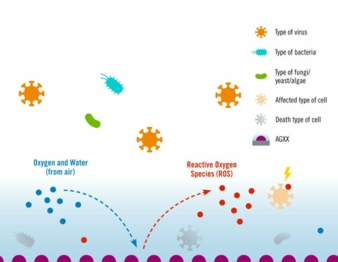06.01.25 – Elevating hygiene in textiles
An antimicrobial additive for textile functionalization
Microorganisms pose a significant threat to human health. Did you know that 11 million people die from sepsis each year, mostly caused by bacteria? Until now, primarily antimicrobial technologies based on the release of silver ions have been used in textiles.
However, silver ions must be constantly released in order to effectively kill germs. Various studies suggest that this poses a risk to humans and the environment. As part of the ongoing evaluation of all antimicrobial technologies by the European Chemicals Agency (ECHA), more than 50% of silver ion-based technologies have already been deemed as not approvable and not even one of them has been approved. Therefore, it is expected that with the completion of this evaluation (ECHA Review Programme), the vast majority of today’s available silver ion technologies will be banned. There is therefore an urgent need for alternatives to these silver ion technologies.
Regulatory-compliant and continuously regenerated
One such alternative is the additive “AGXX”, which can be used in compliance with regulatory requirements both today and in the future. By using this additive, manufacturers can be assured that they are using a solution that meets the highest standards of environmental protection and consumer safety – also in the future.
The mechanism of action of “AGXX” is based on a catalytic reaction triggered by the interaction of two precious metals: silver and ruthenium. In this process, oxygen is converted into reactive oxygen species (ROS) in the presence of humidity. The ROS kill all types of microorganisms by first destroying their outer membranes and then the organelles and DNA of the microorganisms. In addition, there is a microelectric field between the two precious metals that affects important functions of the cell membrane, thus accelerating the killing of the microorganisms. What is unique about this mechanism is that “AGXX” is continuously regenerated and not consumed. The antimicrobial efficacy has been shown against over 130 microorganisms, including silver-resistant E. coli strains. This demonstrates that the mechanism of action is not based on the release of harmful silver ions into the environment.
Useable for a variety of textiles
The additive “AGXX” can be incorporated into textiles and polymers in particulate form. The effectiveness of the technology in various materials, especially in water absorbing textiles and textile finishes such as Lyocell fibres, nylon fibres, and via the padding process, has been confirmed by numerous tests conducted by independent microbiological laboratories. Antimicrobial efficacy tests were conducted according to the test methods ISO 22196 and ISO 20743, where all textiles showed an excellent antimicrobial efficacy, i.e. achieving a log reduction of at least 3 (corresponding to a bacteria reduction of >99.9%). This efficacy was maintained even after 100 wash cycles. In addition to this outstanding antimicrobial activity, “AGXX” is not cytotoxic (ISO10993-5 test) and is also listed as an ACP by Oeko-Tex.
These characteristics make “AGXX” ideal for a wide range of textiles. For example, the antimicrobial technology can be used in medical textiles to prevent the spread of harmful microorganisms in sensitive areas such as hospitals or nursing homes. In addition, “AGXX” prevents sports textiles from developing unpleasant odours as the additive kills the bacteria which break down the sweat to produce that smell. Besides this, “AGXX” can be used in many other textile applications in our everyday lives, such as bedding, workwear, footwear, carpets, and more.


